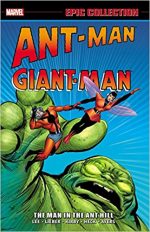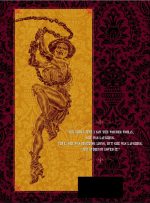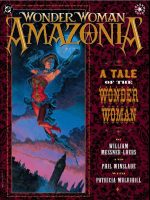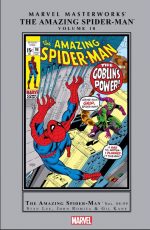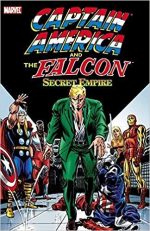
By Steve Englehart, Mike Friedrich, Sal Buscema & various (Marvel)
ISBN: 978-1-3029-0422-7
Created by Joe Simon & Jack Kirby in an era of frantic patriotic fervour, Captain America was a dynamic and highly visible response to the horrors of Nazism and the threat of Liberty’s loss. He faded away during the post-war reconstruction and briefly reappeared after the Korean War: a harder, darker sentinel, ferreting out monsters, subversives and the “commies†who lurked under every American bed.
Then he vanished once more until the burgeoning Marvel Age resurrected him just in time to experience the turbulent, culturally divisive 1960s. Perhaps it’s just coincidence but at the time the USA were just getting heavily involved in a conflict in Southeast Asia…
This sterling collection reprints issues #169-186 (January-August 1974) of his monthly comicbook and shows the once convinced and confirmed Sentinel of Liberty as the troubled man: unhappy and uncomfortable as a symbol of a divided nation, but looking to make the best of things and carve himself a new place in the Land of the Free. Real world events were about to put paid to that American dream…
In response to a subtle vengeance ploy by advertising exec and part-time supervillain Viper, one of the Star-Spangled Avenger’s most durable enemies sort-of resurfaced in the tense opening gambit of a certified Conspiracy thriller as ‘…When a Legend Dies!’ (written by Steve Englehart and Mike Friedrich with art by Sal Buscema & Frank McLaughlin).
Those long-laid plans began to finally bear bitter fruit as anti-Captain America TV spots made people doubt the honesty and sanity of the nation’s greatest hero. As Sam Wilson – AKA The Falcon – and his “Black Power†activist girlfriend Leila Taylor left for the super-scientific African nation of Wakanda in search of increased powers and enhanced effectiveness, Cap battled third-rate villain the Tumbler who very publicly ambushed the hero for no discernible reason.
In the heat of battle the Sentinel of Liberty seemed to go too far and the thug died…
‘J’Accuse!’ (with Englehart solo-scripting and Vince Colletta inking) saw Cap beaten and arrested by too-good-to-be-true neophyte crusader Moonstone, whilst in Africa Leila is kidnapped by former Harlem hoodlum Stone-Face: far from home and hungry for some familiar foxy friendship…
The enigma expanded in #171 as ‘Bust-Out!’ found Cap forcibly sprung from jail by a mysterious pack of “supporters†even as Black Panther and the newly-flying Falcon crushed Stone-Face preparatory to a quick dash back to America and a reunion with Cap.
‘Believe it or Not: The Banshee!’ began with Cap and the Falcon reuniting to be beaten by Moonstone. Narrowly escaping detention by his obscurely occluded masters, the hard-luck heroes follow a lead to Nashville, encounter the fugitive mutant Master of Sound, and stumble into a secret pogrom against Homo Superior citizens.
For long months mutants had been disappearing unnoticed, but now the last remaining X-Men – Cyclops, Marvel Girl and Professor Charles Xavier – had tracked them down only to realise that Captain America’s problems also stemmed from ‘The Sins of the Secret Empire!’ whose ultimate goal was the conquest of the USA.
Eluding capture by S.H.I.E.L.D., Steve and Sam infiltrate the clandestine Empire, only to be exposed and confined in ‘It’s Always Darkest!’ before turning the tables and saving the day in #175’s ‘…Before the Dawn!’ wherein a horrific grand plan is revealed, all mutants liberated and the true culprits captured.
In a shocking final scene, the ultimate instigator is unmasked and shockingly dispatched deep within the sacrosanct White House itself…
At this time, America was a nation reeling from a loss of idealism caused by the daily-televised horror of the Vietnam War, the ever-unfolding Watergate scandal and the partial exposure of President Nixon’s many crimes and misdemeanours.
The painful waking-up to smell some pretty rancid coffee and stomaching the nauseating public revelation that politicians are generally unpleasant – and even possibly ruthless, wicked exploiters – kicked the props out of most Americans who had an incomprehensibly rosy view of their leaders, so a conspiracy that reached into the halls and backrooms of government was extremely controversial yet oddly attractive in those distant, simpler days…
In the days that follow shocked, stunned Steve Rogers searches his soul and realises he cannot be the symbol of such a country. Despite arguments and advice from his Avenging allies he decides that ‘Captain America Must Die!’
Unable to convince him otherwise Sam Wilson carries on alone…
And on that staggering cliffhanger note this controversial collection concludes…
Despite the odd cringeworthy moment (if you’ve already lived through the dialogue of this era of “blaxsploitation†and painfully-growing ethnic awareness once, you’ll know what I mean, Ma-aan) this saga of matchless courage and indomitable heroism is a fast-paced, action-packed, totally engrossing fights ‘n’ tights yarn no comics fan will care to miss, and joking aside, the cultural significance of this story was crucial in informing the political consciences of the youngest members of the post-Watergate generation…
Above all else though, Secret Empire is a fabulously fun tale of a true American Dreamer, still painfully relevant for a new generation who may not be aware of the power and perils of electioneering and the people who beg us to trust them…
© 1974, 2016 Marvel Characters, Inc. All rights reserved.

